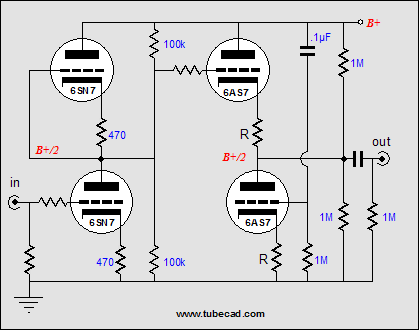> looks like a servo tube. amp factor 2, Ip=125 ma. weird.
It was THE voltage-regulator pass-tube. A 7905, but without the reference and error-amp; essentially the big transistor in a 7805 to which you added the rest of the reguator.
2A3 was used before, but it has a fairly high plate drop for a given current. For a similar cathode, you get lower plate drop with a lower Mu. But if Mu is too low, the drive swing becomes insane. So there is a practical limit.
For a conventional audio amplifier, using some rules of thumb for R-C coupled drivers, and assuming the driver eats the power amp supply voltage, the minumum Mu is about 5 for a fix-biased tube, maybe 4 for self-bias (since some voltage is dropped in the bias resistor).
For the common voltage regulator configurations, for semi-constant output, for reasonable efficiency, you don't have to swing the grid such a large proportion of supply voltage, and it does not have to be linear enough to listen to. So the pass-tube Mu can be low, 3 or even 2. That (plus the bigger heater) lets a 6AS7 pass current with much lower voltage drop than a 2A3. (Also the insulated cathodes mean you may not need a dedicated heater winding.)
A 6AS7 is a poor choice for audio (don't let that stop you). The grid drive is enormous, requiring heroic drivers. The self-bias losses are also enormous. Fixed bias reduces those losses, but the very low Mu means that if the current is wrong, you need a BIG change of grid voltage to correct it. That plus loose specs and apparently sloppy production (it is "only a pass-tube") means you can't predict the bias accurately, and two tubes won't match except by accident.
And in my estimation, it wasn't any kind of brilliant design for 1949, it was a toss-off. They beefed-up an older low-Mu triode, loosened the grid for lower Mu, and called it "done". They could have made it a little more efficient even with the older technology. They could have made it more linear; the techniques were well known in the 1930s. They didn't have to make it very good to sell enough to be profitable, so they didn't bother.
As an audio amp, you will probably run out of drive before you swing the 6AS7 to its limits.
It is much more linear up around 70-100mA than it is down below 30mA, because it was made to live at high current (if you only wanted 30mA, there were cheaper tubes).
6336 is the much-improved version, improved for power. Twice the heater power and cathode area and plate dissipation. Lower Mu, which requires a harder-working driver (anything big enough to need 6336 should not gripe about driver costs).
Banks of 6AS7/6080 were used in precision oscilloscopes, and apparently in military radar systems. Some switched to a lesser number of 6336. It seems the USSR decided to make a monster 6AS7 for similar chores, hence the 6c33.
> must have major grid current or something.
I don't think so. The maximum grid resistance is actually lower for 6550 or 8417 than for 6AS7. It seems to work fine with 470K grid resistors. Anyway, even large grid current in a large grid resistor does not have a huge effect on a tube with such low Mu and such large operating bias.

































